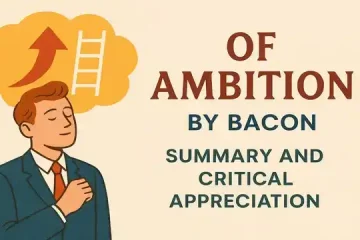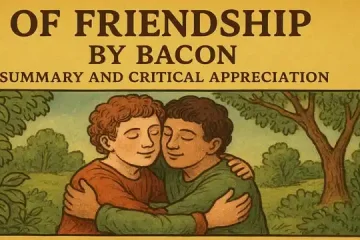Introduction:
The essay entitled Female Orators is a satire on the talkativeness of women. Addison exposes the foible of women who talk incessantly upon trivial matter in an amusing manner. He is cynical and indecent in any part of the essay. It is noted that his irony is gentle and his satire is free from fierceness or cruelty. The reasons which inspire different women to talk so copiously and eloquently are stated in such a way as to excite our laughter and yet not to lower women in our esteem or to degrade them. The essay is made spicy with the example of an old lady who made an unhappy marriage the subject of a month’s conversation.
Summary of the Essay:
Some ancient authors observe that Socrates was taught the art of fluent speaking by a female teacher named Aspasia. She went to Athens and taught rhetoric. The writer has found that the females are better suited for the art of oratory than men. Addison thinks that the authority and administration of the different universities should ponder over to fill the rhetoric chairs with she – professors. Men have been praised for being able to talk upon any subject for hours, but females are better because they do not need any subject and they can carry on their speech without any subject. Women can talk forever upon nothing. In order to prove this point, Addison says that he knows a woman who can elaborate upon a subject in a most spontaneous manner. She can speak for a long time upon such topics as the border of a petticoat. She can scold her servant for having broken a cup made of china clay in the most picturesque and rhetorical language. If ladies were permitted to plead in the court, they would have carried the matters to the greatest heights with the art of oratory. This is all the more easily to believe if one sees the ability of the women who sell fish in Britain. They are able to argue effectively and abusively to win their cases. Female orators are of many types: Those who are expert in stirring up the passions, those who are censorious orators, those who are capable in gossips, and those who are coquettes. The first type is one that arouses the passions. An example of this type was Socrates’ wife. The second type indulges in abusive language and bitter criticism, are known as fault – finding orators. Addison admires their power of eloquence and imagination. They have a remarkable inventiveness of mind and grasp over the effective use of language. They possess a great skill for elaborating upon the smallest mistake another woman makes or the most trivial fault she has. They use their skill to disparage another woman. These female orators have the power of telling stories about other women and each time the story is repeated with different colour and is told with the help of different figures of speech. Addison gives an example of this kind. An old lady goes about talking upon one subject, namely a new married couple in the most colourful and imaginative terms. She talks about it for a whole month. She varies her attitude and the description every time she talks about it. She criticises the bride at one place and at another place she expresses sympathy for her. Yet at another occasion, she is seen to make amusing remarks about the bride’s choice of her husband. She exhausts a pair of coach – horses by going around place to place expressing her anxiety about the bride. She at last exhausts her inventive power and ability to speak against marriage. Then, she goes to the bride herself and praises and congratulates her upon having chosen well in her husband. She also tells her how malicious people are saying unjust things about her marriage. The women of this type cannot be taken seriously for their blame or praise. They remain only a device to keep the conversation going. The third type is the gossip. The women of this type can describe in great detail the most trivial of things. The women belonging to this category can describe a lady’s head – dress or about a christening. They know all about each and every dish prepared and served in the neighbourhood. She does not hesitate in praising that son of hers who has not yet learnt to speak. Fourth type of the female orators belongs to the coquette. The women of this type love and hate in the same breath so as to give themselves more scope for conversation. They sigh and laugh without cause. They invent quarrels and obligations with all men of their acquaintances just to have opportunity of talking to them. In order to display their coquettish actions, they stir their limbs and throw their glances or play with their fans.
Addison wonders why women have a greater ability to speak more fluently than men. It has been a puzzle to the writer to assign a cause to this superiority of oratory in females. He thinks that perhaps it is because the females have not the power of retaining their thoughts and they keep on talking, but men have greater power of controlling and putting a check upon their thoughts, hence they do not speak too much. The women express whatever they think. As women talk all the time, it is implied that they think all the time too. Many people are of the opinion that women can dissemble as well as men, but the writer ignores this theory. The writer asks his friend who has studied the structure of the human body, to dissect the tongue of a female and this might lead them to know if the tongue has a certain special liquids or fluids which give her the ability to speak ceaselessly. Perhaps the tongue has certain muscles made up of very flexible and thinner threads which make it more restlessly. Or, perhaps, there are certain muscles in the tongue of a female which make it move up and down in sudden and quick movement. Lastly, there may be some connection, as yet undiscovered, between the tongue and heart and head which keep up a constant supply of liveliness to the tongue. The writer thinks about the remark of Hudibras who is hero of a mock – epic written by Samuel Butler. Hudibras says that tongue is like a race horse the speed of which becomes faster if it carries less weight. The writer thinks the Irishman’s thought to be very natural. He, after some hours’ conversation with a female orator begins to believe that the tongue of a woman is a part of her body which gets no rest except when she is sleep. According to an old ballad, women’s tongues are made of aspen leaves that is why they are always trembling. Next the writer refers to Ovid who was a great classical Latin poet. In one of his works entitled Metamorphoses, he has described the rape of Philomela. After the rape, her seducer, Tereus, cut off her tongue. It kept on speaking even after it had been cut out of the mouth. The writer ridicules the loquacity of the female tongue, not in order to cease its flow completely, but to improve its quality. He compares the tongue to a musical instrument which, at the present, is harsh and unharmonious in its notes because of anger, tendency to find fault or gossip or flirt. He wants that these shortcomings of the tongue should be removed and the tongue should be tuned like a good musical instrument.
Critical Analysis of the Essay:
Introduction:
In the essay entitled Female Orators, Addison exposes the foible of women who talk incessantly upon trivial matter in an amusing manner. The essay is a satire on female garrulity. The essayist begins by pointing out that women are more proficient in the art of oratory than men. Many of them can talk whole hours together upon nothing. The essay shows Addison’s irony at its best. In the present essay, Addison’s irony is gentle and his satire is free from fierceness or cruelty. The reasons which inspire different women to talk so copiously and eloquently are stated in such a way as to excite our laughter and yet not to lower women in our esteem or to degrade them. But it is obvious that the essayist’s purpose is to improve them and so amusing anecdotes have also been used. The possible findings of an anatomist who anatomises a female tongue are uproariously funny. The end of the essay tries to take away the sting of the satire. The essay is enlivened and colour is added to it through the help of illustrations. or imaginary examples and anecdotes. The essay exhibits the aim of the Spectator which was to entertain while instructing.
Thought – content:
Women are more proficient in the art of oratory and eloquence than men. Many women can talk whole hours together upon nothing. There are different kinds of female orators – those who are adepts in stirring up the passions, those who specialise in fault – finding and censure, those who are gossipers and those who are coquettes. The women are so talkative because they cannot suppress their thoughts, or because there is something about the structure of their tongues making them wonderfully voluble, or because their tongues have little weight to carry. The writer, while he is not averse to female voices, would like women to be prompted in their talk by good nature, truth, and sincerity, instead of by anger, censoriousness, gossiping and coquetry.
The Use of Allusions and Anecdotes:
Addison uses several allusions in the course of his essays. He uses them to illustrate, convince, add force to his argument, enhance the ironic and satiric effect. The variety of allusions is great. There are historical allusions, Biblical, literary, and mythological allusions. He also uses the quotation from classical or modern author and these quotations are very apt for the subject. This essay has references to Socrates, his teacher Aspasia, Hudibras, the hero of Samuel Butler’s satiric poem of the same name, a reference and quotation from the wife of Bath’s tale, a quotation from the ancient Latin poet, Ovid. In this essay we also have an allusion to the French philosopher, Descartes. The essay is made spicy with the example of an old lady who makes an unhappy marriage the subject of a month’s conversation and that of Mrs. Fiddle – Faddle who can entertain her company a whole afternoon together with the wit of her little boy before he was able to speak.
Humour, Satire and Irony:
The essay is a masterpiece of humorous – writing. The loquacity of women and its possible causes are here dwelt upon with delicious humour. This essay makes us almost rock with laughter. Here Addison’s satire is also very pungent. This essay is a satire on women’s garrulity or volubility. Addison says:
“It has been said in praise of some men, that they could talk whole hours together upon anything; but it must be owned to the honour of the other sex, that there are many among them who can talk whole hours upon nothing. Coquettes are capricious and vain in their talk and they speak mostly to no other purpose than to get an opportunity of moving a limb or changing a posture. One reason why women talk so much is that they cannot suppress their thoughts.”
In this essay, irony is seen at its best. This essay is a string of ironical remarks and observations. Saying that he has often looked upon the art of oratory as the most proper for the female sex, the writer suggests (ironically, of course) that the university should fill the rhetoric chairs with she professors. The writer says that there are many women who can talk whole hours together upon nothing. Apparently, this remark seems to be a compliment to women, but actually the author conveys to us his criticism of the superficiality and purposeless glibness of the fair sex. The writer
says, “I have known a woman branch out into a long extempore dissertation upon the edging of a petticoat, and chide her servant for breaking a China cup, in all the figures of rhetoric.” The irony here is most pungent and extremely comic. The reasons which Addison gives later in the essay for this talent of a ready utterance in women show an equally ironical treatment of the subject.




